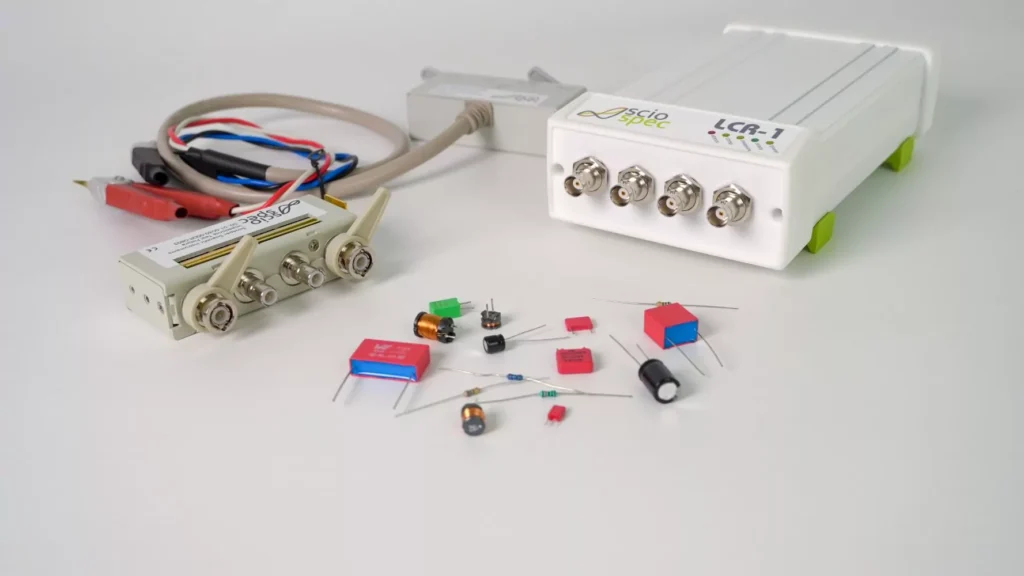Introduction
Imagine being able to scrutinize the building blocks of electronic circuits with precision and ease. That’s where LCR meters come into play, acting as the magnifying glass for electrical component analysis. These instruments are pivotal in measuring the inductance (L), capacitance (C), and resistance (R) of electronic components, hence their acronymic name. Whether it’s for ensuring that a capacitor meets its specified parameters or deciphering the complex impedance of an inductor, LCR meters are the go-to tools for engineers and technicians alike.
Among the pantheon of LCR meters, the Sciospec LCR-1 stands out as a paragon of high-performance measurement. Its capability to deliver accurate readings swiftly positions it not just as a tool, but as an asset in the arsenal of anyone involved in electronics. The LCR-1 doesn’t simply measure; it ensures that each component’s performance aligns meticulously with its intended design, a necessity for both the prototype stage and mass production.
As we prepare to delve deeper into the world of LCR meters, it’s important to recognize the user-friendly nature and advanced features that define today’s instruments. Far from being the clunky, intimidating devices of the past, modern LCR meters like the Sciospec LCR-1 embody a blend of simplicity and sophistication. They promise to transform the seemingly intricate task of electrical measurement into a seamless part of the workflow. With this introduction, we set the stage for a journey through understanding, application, and ultimately, selection of the right LCR meter for your needs.
Understanding LCR Meters
Peeling back the layers of sophisticated electronic testing equipment, we begin to understand the core functions and significance of LCR meters. These devices are not just a staple in the toolkit of engineers and technicians; they are pivotal in maintaining the integrity and functionality of electronic components. But what exactly are LCR meters, and how do they work their magic in measuring inductance (L), capacitance (C), and resistance (R)?
Demystifying the Functionality of LCR Meters
At their essence, LCR meters are precision instruments designed to measure the electrical properties of passive components. The ‚LCR‘ stands for the three fundamental passive elements it is equipped to analyze: inductance, capacitance, and resistance. To do this, an LCR meter sends an alternating current (AC) signal through the component under test and observes the resulting voltage across it. By examining the phase shift and amplitude changes between the voltage and the current, the meter can determine the values of L, C, and R with remarkable precision. This process allows technicians to decode the characteristics of each component and understand how they will behave in an electrical circuit.
The Pivotal Role of LCR Meters Across Industries
The importance of LCR meters transcends multiple industries. In the realm of electronics manufacturing, they ensure that components like capacitors and inductors meet stringent quality standards. The telecommunications sector relies on these meters to maintain and troubleshoot the complex circuits found within communication devices. Meanwhile, in the automotive industry, LCR meters test the materials used in sensors and actuators, ensuring safety and functionality. It’s hard to overstate the critical role LCR meters play in the production and maintenance of virtually all modern technology.
Key Components and Functionalities of LCR Meters
Delving into the anatomy of an LCR meter, one finds several key components and functionalities that make it a versatile tool. The frequency range is a vital specification, as different components react differently across various frequencies. Advanced meters, like the Sciospec LCR-1, can operate across a sweeping range from a mere 100 millihertz to an impressive 10 megahertz, catering to a broad spectrum of testing scenarios. Accessories also play a crucial role; with the right adapters, users can test everything from individual components to foils and liquids, expanding the horizons of what can be measured. Whether it’s through manual tinkering or automatic settings, features like averaging and compensation contribute to the LCR meter’s ability to provide accurate and reliable data every time.
Benefits of Using LCR Meters
In the realm of electronics, precision is everything. LCR meters stand out as the gatekeepers of component integrity, ensuring that every capacitor, inductor, and resistor functions within its specified parameters. But what exactly elevates these instruments above simpler testing devices? Let’s delve into the advantages they provide for precise component analysis.
Precision in Component Analysis
When it comes to measuring the inductance (L), capacitance (C), and resistance (R) of components, accuracy is paramount. Sciospec’s LCR-1 meter, for instance, is renowned for its high-end accuracy. It’s not just about getting a measurement; it’s about getting the right measurement the first time. This precision allows engineers and technicians to trust the components they are working with, which is crucial when designing sensitive electronic circuits or performing quality control in manufacturing.
Unrivaled Range, Accuracy, and Speed
The Sciospec LCR-1 doesn’t compromise on range or speed, either. Boasting an impressive frequency range from 100 mHz to 500 kHz, extendable up to 10 MHz, this meter can handle an expansive array of components—ranging from tiny resistances of 1 mO to a vast 1 TO and inductances from 1 nH to 1 TH. The ability to switch between manual and automatic measurement modes adds to its versatility, making it a swift tool for routine testing and complex analyses alike.
Simplifying Complex Measurements
Complexity in measurement can often lead to errors or inefficiencies. Here is where LCR meters shine, by simplifying the process. With features such as averaging, compensation, and adjustable integration time, LCR meters like the Sciospec LCR-1 streamline the testing procedure. This simplification ensures efficiency and consistency in measurements, which is especially beneficial in industries where time is of the essence and the margin for error is slim.
By incorporating advanced technologies into user-friendly interfaces, LCR meters empower users to perform sophisticated measurements with ease. Whether you’re a seasoned professional or a newcomer in the field of electrical engineering, devices like the LCR-1 make it possible to achieve laboratory-grade results without requiring extensive training or experience.
Practical Applications of LCR Meters
The practicality and versatility of LCR meters extend far beyond the bench of an electronics workshop. In the realm of quality control, research and development, and production processes, these instruments are indispensable for ensuring the integrity and performance of electronic components. Let’s delve into how these meters play a pivotal role in various applications.
Quality Assurance in Manufacturing
Imagine an assembly line where electronic components must be verified for conformity before being integrated into sophisticated devices. Here, LCR meters step in as gatekeepers of quality assurance. They help manufacturers uphold strict tolerances by swiftly identifying components that deviate from desired electrical specifications. This not only maintains product reliability but also mitigates the risk of costly recalls or failures in the field. For instance, in the production of smartphones, every capacitor’s capacitance and resistance need to measure up to precise standards to ensure longevity and functionality of the device.
Optimizing Circuit Designs
In the circuit design phase, engineers rely on LCR meters to select optimal components that meet their stringent requirements. By measuring inductance, capacitance, and resistance with high precision, they can iterate designs quickly, reducing time to market for new products. The Sciospec LCR-1 meter, with its advanced features and impressive frequency range, facilitates this process by providing detailed insights into component behavior, which is particularly crucial for high-frequency applications where parasitic effects can make or break a design.
Enhancing Productivity and Performance
LCR meters are not just about catching flaws; they’re also productivity enhancers. Automated testing setups integrate LCR measurements to expedite the evaluation process, allowing for more components to be tested in less time. This efficiency is essential in industries like automotive manufacturing, where the volume of electronic components such as sensors and actuators is vast, and the margin for error is minimal. The Sciospec LCR-1 meter, with its capability of integrating into automated systems, exemplifies how such tools can boost throughput without compromising accuracy.
As we have seen, LCR meters serve a multitude of purposes across various industries, proving their worth as more than just simple benchtop instruments. They are key players in the continuous push towards higher quality, better performance, and increased productivity in the world of electronics.
Choosing the Right LCR Meter for Your Needs
Embarking on the journey to select an LCR meter that fits your project’s needs can be as important as understanding the principles behind the measurements themselves. With various models and brands available, how do you navigate the sea of specifications to ensure you get the right tool for the job? Let’s delve into the factors that should guide your decision-making process.
Key Considerations for Selection
When selecting an LCR meter, start by considering the frequency range necessary for your applications. This is crucial because different components react differently across frequencies, and your LCR meter must cover the range relevant to your tests. Measurement accuracy is another cornerstone; the precision of your instrument directly affects the reliability of your results. Finally, don’t overlook special features such as compensation capabilities, test speeds, and additional functionalities that may be unique to certain models.
Comparing Models and Brands
Comparison is key in making an informed decision. The Sciospec LCR-1 meter, for instance, provides a broad range of measurement capabilities, from resistances as low as 1 milliohm up to 1 teraohm, capacitances from 10 femtofarads to 1 kilofarad, and inductances from 1 nanohenry to 1 terahenry. It boasts a base accuracy of 0.01% and an impedance range challenging even top-line impedance analyzers. By comparing these specifications against other meters in the market, you can gauge which instrument aligns best with your testing requirements.
Assessing Project Requirements
Understanding the specific demands of your projects is the final step. If speed is vital due to high-throughput testing, the LCR meter you choose should be capable of rapid measurements without sacrificing accuracy. For projects dealing with a variety of component types, look for versatility in test adapters and fixtures. And if your work involves non-standard frequencies or components, ensure that the LCR meter can be customized to accommodate these unique conditions.
Remember, the devil is often in the details. Accuracy contour plots can provide deeper insight into how well an LCR meter performs across its entire range of frequencies and impedances. By studying these plots, available in datasheets like those of Sciospec LCR-1, you can understand the nuances of an LCR meter’s performance and make a choice that’s truly tailored to your needs.
As our journey through the world of LCR meters reaches its apex, we find ourselves standing at the threshold of endless possibilities. With the power to delve into the heart of electronic components, these instruments have transformed the realm of engineering and electronics. The Sciospec LCR-1, a beacon of precision and efficiency, epitomizes the evolution of LCR meters, making measurement an art form rather than a chore. Now that you’ve gained insight into the functioning and significance of LCR meters, it’s time to take the next step. The Sciospec LCR-1 awaits, ready to join your quest for precision and excellence. Embrace the future of electrical measurement by exploring our website and experiencing the Sciospec difference for yourself. Your journey to mastering the intricacies of electrical components starts here. Dive into the fascinating world of LCR meters today, and elevate your engineering prowess to unparalleled heights.





